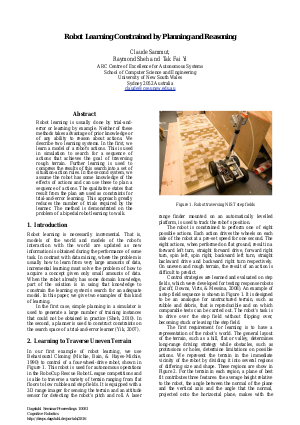Robot Learning Constrained by Planning and Reasoning
Authors Claude Sammut, Raymond Sheh, Tak Fai Yi
-
Part of:
Volume:
Dagstuhl Seminar Proceedings, Volume 10081
Part of: Series: Dagstuhl Seminar Proceedings (DagSemProc) - License:
 Creative Commons Attribution 4.0 International license
Creative Commons Attribution 4.0 International license
- Publication Date: 2010-11-23
File

PDF
DagSemProc.10081.14.pdf
- Filesize: 286 kB
- 6 pages
Document Identifiers
Metrics
- Access Statistics
-
Total Accesses (updated on a weekly basis)
0Document
0Metadata
Abstract
Robot learning is usually done by trial-anderror or learning by example. Neither of these methods takes advantage of prior knowledge or of any ability to reason about actions. We describe two learning systems. In the first, we learn a model of a robot's actions. This is used in simulation to search for a sequence of actions that achieves the goal of traversing rough terrain. Further learning is used to compress the results of this search into a set of situation-action rules. In the second system, we assume the robot has some knowledge of the effects of actions and can use these to plan a sequence of actions. The qualitative states that result from the plan are used as constraints for trial-and-error learning. This approach greatly reduces the number of trials required by the learner. The method is demonstrated on the problem of a bipedal robot learning to walk.
Cite As Get BibTex
Claude Sammut, Raymond Sheh, and Tak Fai Yi. Robot Learning Constrained by Planning and Reasoning. In Cognitive Robotics. Dagstuhl Seminar Proceedings, Volume 10081, pp. 1-5, Schloss Dagstuhl – Leibniz-Zentrum für Informatik (2010)
https://doi.org/10.4230/DagSemProc.10081.14
BibTex
@InProceedings{sammut_et_al:DagSemProc.10081.14,
author = {Sammut, Claude and Sheh, Raymond and Yi, Tak Fai},
title = {{Robot Learning Constrained by Planning and Reasoning}},
booktitle = {Cognitive Robotics},
pages = {1--5},
series = {Dagstuhl Seminar Proceedings (DagSemProc)},
ISSN = {1862-4405},
year = {2010},
volume = {10081},
editor = {Gerhard Lakemeyer and Hector J. Levesque and Fiora Pirri},
publisher = {Schloss Dagstuhl -- Leibniz-Zentrum f{\"u}r Informatik},
address = {Dagstuhl, Germany},
URL = {https://drops.dagstuhl.de/entities/document/10.4230/DagSemProc.10081.14},
URN = {urn:nbn:de:0030-drops-28163},
doi = {10.4230/DagSemProc.10081.14},
annote = {Keywords: }
}
